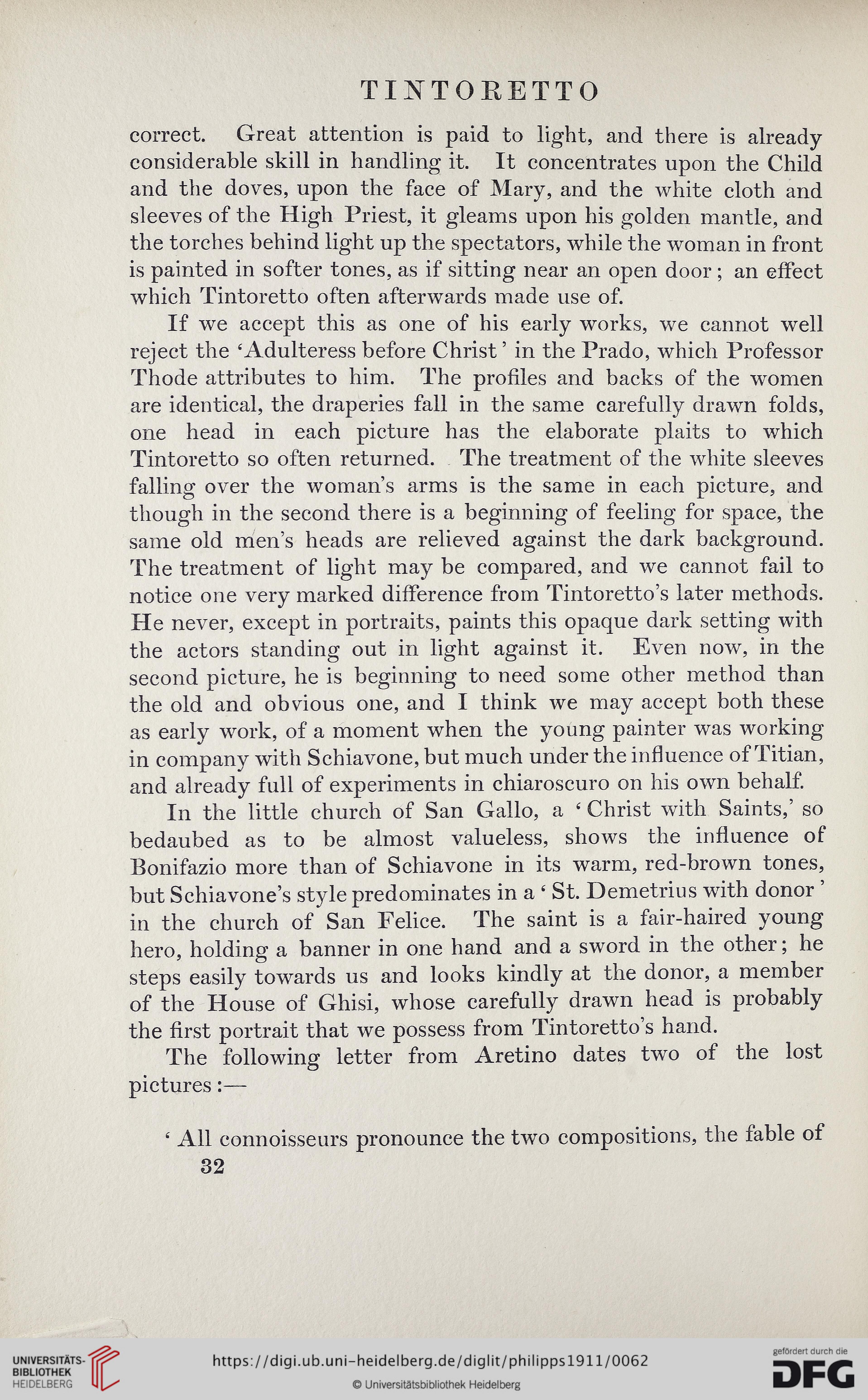TINTORETTO
correct. Great attention is paid to light, and there is already
considerable skill in handling it. It concentrates upon the Child
and the doves, upon the face of Mary, and the white cloth and
sleeves of the High Priest, it gleams upon his golden mantle, and
the torches behind light up the spectators, while the woman in front
is painted in softer tones, as if sitting near an open door ; an effect
which Tintoretto often afterwards made use of.
If we accept this as one of his early works, we cannot well
reject the ‘Adulteress before Christ ’ in the Prado, which Professor
Thode attributes to him. The profiles and backs of the women
are identical, the draperies fall in the same carefully drawn folds,
one head in each picture has the elaborate plaits to which
Tintoretto so often returned. The treatment of the white sleeves
falling over the woman’s arms is the same in each picture, and
though in the second there is a beginning of feeling for space, the
same old men’s heads are relieved against the dark background.
The treatment of light may be compared, and we cannot fail to
notice one very marked difference from Tintoretto’s later methods.
He never, except in portraits, paints this opaque dark setting with
the actors standing out in light against it. Even now, in the
second picture, he is beginning to need some other method than
the old and obvious one, and I think we may accept both these
as early work, of a moment when the young painter was working
in company with Schiavone, but much under the influence of Titian,
and already full of experiments in chiaroscuro on his own behalf.
In the little church of San Gallo, a ‘ Christ with Saints,’ so
bedaubed as to be almost valueless, shows the influence of
Bonifazio more than of Schiavone in its warm, red-brown tones,
but Schiavone’s style predominates in a ‘ St. Demetrius with donor ’
in the church of San Felice. The saint is a fair-haired young
hero, holding a banner in one hand and a sword in the other; he
steps easily towards us and looks kindly at the donor, a member
of the House of Ghisi, whose carefully drawn head is probably
the first portrait that we possess from Tintoretto’s hand.
The following letter from Aretino dates two of the lost
pictures
‘ All connoisseurs pronounce the two compositions, the fable of
32
correct. Great attention is paid to light, and there is already
considerable skill in handling it. It concentrates upon the Child
and the doves, upon the face of Mary, and the white cloth and
sleeves of the High Priest, it gleams upon his golden mantle, and
the torches behind light up the spectators, while the woman in front
is painted in softer tones, as if sitting near an open door ; an effect
which Tintoretto often afterwards made use of.
If we accept this as one of his early works, we cannot well
reject the ‘Adulteress before Christ ’ in the Prado, which Professor
Thode attributes to him. The profiles and backs of the women
are identical, the draperies fall in the same carefully drawn folds,
one head in each picture has the elaborate plaits to which
Tintoretto so often returned. The treatment of the white sleeves
falling over the woman’s arms is the same in each picture, and
though in the second there is a beginning of feeling for space, the
same old men’s heads are relieved against the dark background.
The treatment of light may be compared, and we cannot fail to
notice one very marked difference from Tintoretto’s later methods.
He never, except in portraits, paints this opaque dark setting with
the actors standing out in light against it. Even now, in the
second picture, he is beginning to need some other method than
the old and obvious one, and I think we may accept both these
as early work, of a moment when the young painter was working
in company with Schiavone, but much under the influence of Titian,
and already full of experiments in chiaroscuro on his own behalf.
In the little church of San Gallo, a ‘ Christ with Saints,’ so
bedaubed as to be almost valueless, shows the influence of
Bonifazio more than of Schiavone in its warm, red-brown tones,
but Schiavone’s style predominates in a ‘ St. Demetrius with donor ’
in the church of San Felice. The saint is a fair-haired young
hero, holding a banner in one hand and a sword in the other; he
steps easily towards us and looks kindly at the donor, a member
of the House of Ghisi, whose carefully drawn head is probably
the first portrait that we possess from Tintoretto’s hand.
The following letter from Aretino dates two of the lost
pictures
‘ All connoisseurs pronounce the two compositions, the fable of
32




